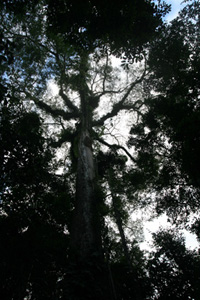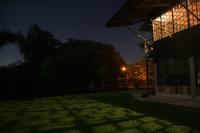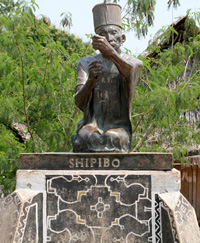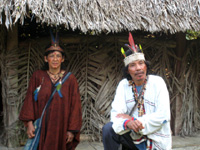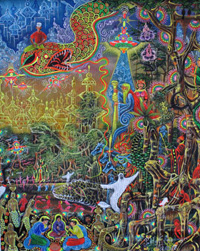PRACTICE
The ayahuasca ceremony performed by Peruvian Indians has its own set of rules. After sunset the participants of the ceremony meet in a special hut (maloka), which is usually in the close contact with nature and if possible, it is situated quite out of the urban agglomeration. The shaman hands everyone la medicina in a small cup; a usual dosage is 1 dcl of liquid, depending on one’s body weight. The consequent effect can be summed up in three phases.
PHASE 1 - “reality check”: Usually no special indications are noticed in the first 30 to 60 minutes. The first symptom is a pins-and-needles sensation in the hands and chest, which is perceived as an intense exchange of energy with the surroundings. A novice may fail to notice this state for a relatively long time, while an experienced shaman will immediately recognize the first symptoms of “mareacion” and slowly start singing icaros, personalized evocative songs whose rhythm and tune often come directly from the depth of the altered state of consciousness. Soon, there is
PHASE 2 - “overlap of worlds”, when the consciousness is still fully present in conventional reality, which seems to be visually changed. The view of common things is enriched with colourful geometric patterns, and one’s attention begins to be bombarded with a flood of new unsorted, heterogeneous perceptions. Only during
PHASE 3 is the consciousness fully open to a new mode of perception. The ordinary sensory world disappears, and the attention is able to tune to the changed reality of “other worlds” full of immersive visions. This phase can be of various intensity and depends significantly on the preceding purification of body and mind. Shamans recommend a diet with no sugar, salt or cooked food for at least one-week before to the ceremony and themselves are on a diet basically all the time. This practise is connected with one of ayahuasca’s many nicknames, la purga, which refers to its ability to remove physical and mental ailments. Owing to the presence of harmaline alkaloid in liana, the beverage is usually regurgitated and everything subjectively perceived as bad and evil metaphorically leaves with it. Ayahuasqueros say that even the process of vomiting teaches you as there occurs, often in connection with strong visions, a catharsis of everything superfluous, problematic and toxic from the body and mind.
From a pragmatic point of view, the ayahuasca ceremony presents a therapeutic method that has been refined for hundreds of years, and it takes months or even years for an experienced ayahuasquero to train a new initiate. If the shaman is not pursuing any particular goal, his role is to function only as a firm point of reference. He should be able to maintain a calm atmosphere and to watch over the ritual participants in the “other world” so he can interfere in the material world should problems arise. He must be accustomed to a mental state connected with intoxication as initiates are often like children, completely entranced by the incredible possibilities of the altered state of mind. This presents a certain danger, as it is easy for an untrained mind literally to get lost, not only in the fascinating levels of absolute beauty, but also in the infernal worlds full of destruction and suffering. If one’s attention is captured by negative topics and cannot free itself, the shaman perceives the situation by his inner sight as the dark, powerful eddy and tries to disperse it with his intensive icaros calling the cyclic perception back into the dimension of conventional reality, from where it can freely take a different route.
It is interesting that, especially with the first experience with ayahuasca, Phases 2 and 3 described above may not arrive at all, even though a full dosage is taken. The shaman explains that only the plant itself chooses whom to accept and what to show them. In general, the effects of the experience can be enhanced by following several simple rules:
- The greatest enemy of the psychedelic experience is fear. The experience of the altered state of consciousness is so unlike conventional perception that a reaction to it may take the form of panic and a spiral of negative fantasies enhanced by strengthened visualisation. Once commenced, the “trip” cannot be cancelled. It is necessary to realize that perception will return to normal itself.
- You can always turn your attention back to the shaman and concentrate on his icaros, which calm wild energies and gently help the consciousness perceive new visions, emotions and associations.
- It is also good to remember that the plant has its own identity to which you can turn with questions or pleas for help, guidance, treatment or advice. The resulting experience will then be influenced significantly by this intimate “communication”.
- You can also communicate with any living thing. Although it seems irrational, it is nonetheless pragmatic to talk to, e.g. your afflicted organs and expect an answer from them.
- While in an altered state of mind, you will be confronted with many fundamental thoughts and non-verbal messages that, unfortunately, you will not remember, although they would prove helpful in conventional reality (in contrast to experience with other psychedelic substances). However, these insights usually pass as quickly as they come. The only way to prevent this process is to immediately transpose the important conclusions into words and to memorize the resulting sentences by repeating them many times. After your “return” you will usually have only these words left.
As has been said elsewhere, it is necessary to address the ayahuasca experience with trust and meekness. Although you may feel many times that you have full control over your state of mind, as ayahuasqueros say, it is the same as with a tiger in a cage: “You think 100 times that you have tamed it or have control over it, but when you enter its cage for the 101st time ...” In reality, the individual ego is not able to dominate the psychedelic state for one simple reason — such a state uncompromisingly disrupts its very substance.
